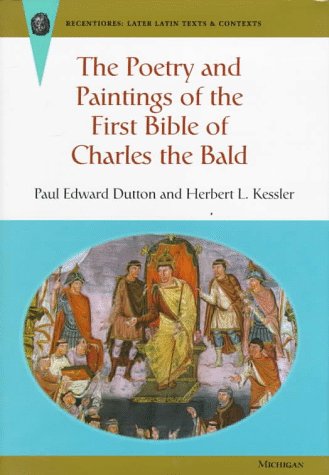Recentiores: Later Latin Texts & Contexts S.
1 total work
The Poetry and Paintings of the First Bible of Charles the Bald
by Paul Edward Dutton and Herbert L. Kessler
Published 15 March 1998
The sumptuously decorated First Bible of Charles the Bald may well be the most famous of all medieval manuscripts. The national library of France counts it as Number 1 among its thousands of Latin manuscripts. Despite its fame, however, the First Bible has remained a magnificent mystery, its poems largely unread and the connection between its poetry and paintings unexplored. In the first full study of its kind, Paul Edward Dutton and Herbert L. Kessler carefully investigate and integrate the Bible's words and pictures and arrive at some surprising discoveries: the identification of the poet, the context of the Bible's production, hands-on changes to the codex, and a new, more political reading of the First Bible's stunning paintings.
The First Bible was made for Charles the Bald (840-877) at the monastery of Saint Martin at Tours. It contains four sets of dedicatory verses, seven sets of "tituli" or inscriptions associated directly with paintings, eight full-page illuminations, and a host of decorated initials and minor illustrations. This study begins with an analysis of the poetry in the codex. Dutton and Kessler identify the probable poet of the new poems and argue that the great Bible was likely made in the summer or early autumn of 845. They reveal textual evidence for a series of late changes to the codex in November 845 as it was rushed to completion. Further, they reinterpret the paintings in the light of the political poetry accompanying them, and they detect the principal architect of the Bible Charles the Bald finally received.
"The Poetry and Paintings of the First Bible of Charles the Bald" will appeal to medievalists, historians, and art historians, as well as to anyone interested in how words and pictures interrelate, and how political messages are conveyed in art.
Paul Edward Dutton is Professor of History and Humanities, Simon Fraser University, Burnaby, British Columbia. Herbert L. Kessler is Charlotte Bloomberg Professor in the School of Arts and Sciences and Chair of the Department of the History of Art, Johns Hopkins University.
The First Bible was made for Charles the Bald (840-877) at the monastery of Saint Martin at Tours. It contains four sets of dedicatory verses, seven sets of "tituli" or inscriptions associated directly with paintings, eight full-page illuminations, and a host of decorated initials and minor illustrations. This study begins with an analysis of the poetry in the codex. Dutton and Kessler identify the probable poet of the new poems and argue that the great Bible was likely made in the summer or early autumn of 845. They reveal textual evidence for a series of late changes to the codex in November 845 as it was rushed to completion. Further, they reinterpret the paintings in the light of the political poetry accompanying them, and they detect the principal architect of the Bible Charles the Bald finally received.
"The Poetry and Paintings of the First Bible of Charles the Bald" will appeal to medievalists, historians, and art historians, as well as to anyone interested in how words and pictures interrelate, and how political messages are conveyed in art.
Paul Edward Dutton is Professor of History and Humanities, Simon Fraser University, Burnaby, British Columbia. Herbert L. Kessler is Charlotte Bloomberg Professor in the School of Arts and Sciences and Chair of the Department of the History of Art, Johns Hopkins University.
